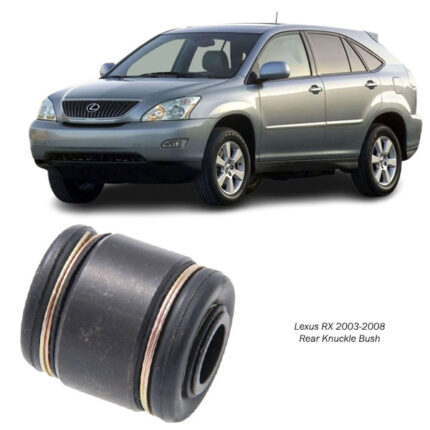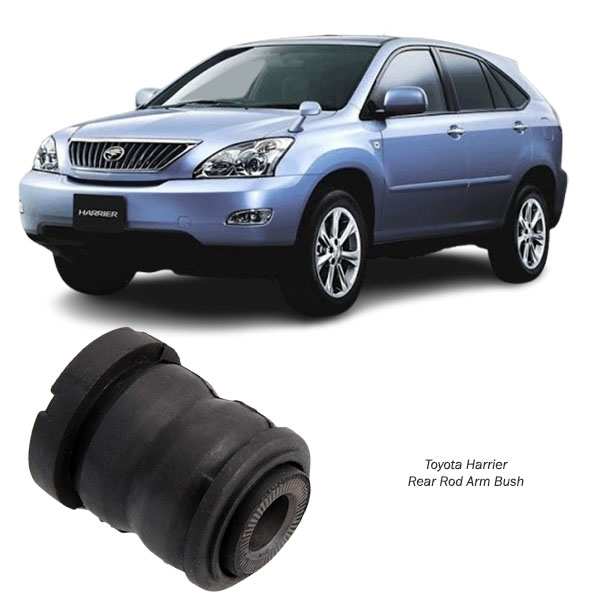-10%
Get Toyota Harrier MCU35 Rear Rod Arm Bush TAB-316 in Kenya
The rod arm bush, also known as the control arm bushing, is a fundamental component in a vehicle’s suspension system, playing a crucial role in connecting the control arm to the vehicle’s frame or chassis. This bushing is typically made of rubber or polyurethane and is designed to provide flexibility and damping characteristics while maintaining structural integrity. Here’s an in-depth exploration of the rod arm bush, covering its functions, importance, signs of wear or failure, and maintenance considerations.
Functions of Rod Arm Bush
- Vibration Dampening: The primary function of the rod arm bush is to absorb and dampen vibrations and shocks from the road surface. As the vehicle moves over bumps and uneven terrain, the control arm moves accordingly. The rubber or polyurethane material of the bushing cushions these movements, preventing them from being transmitted directly to the vehicle’s frame. This dampening effect improves ride comfort by reducing the harshness felt by occupants inside the vehicle.
- Noise Reduction: Alongside vibration dampening, the rod arm bush also helps in reducing noise generated from the suspension system. By isolating the control arm’s movements, it minimizes the transmission of suspension-related noise into the vehicle cabin, contributing to a quieter driving experience.
- Flexibility and Movement: The bushing allows controlled movement of the control arm as the suspension travels through its range of motion. This flexibility is crucial for maintaining stability and ensuring that the wheels maintain proper contact with the road surface, especially during cornering, braking, and acceleration. It also helps in absorbing lateral forces and impacts, thereby enhancing overall vehicle handling and maneuverability.
- Maintenance of Suspension Geometry: A properly functioning rod arm bush helps in maintaining the correct alignment and geometry of the suspension system. It keeps the control arm securely attached to the frame or chassis, preventing excessive movement or misalignment. This alignment stability is essential for ensuring predictable handling, steering response, and tire wear.
- Longevity and Durability: The rod arm bush is subjected to constant stress and movement during vehicle operation. Its design and material composition are engineered to withstand these forces while maintaining durability and longevity. However, over time and with extended use, the bushing can wear out, leading to a degradation in its damping abilities and structural integrity.
Signs of Worn or Failing Rod Arm Bush
- Increased Noise: Worn rod arm bushings can lead to increased suspension noise, such as clunking or banging sounds when driving over bumps or rough roads. This noise is typically caused by excessive play or movement in the bushing, allowing the control arm to impact other suspension components.
- Vibration and Harshness: As the bushing wears out, it may lose its ability to effectively dampen vibrations. This can result in increased vibration felt through the steering wheel or vehicle chassis, especially at higher speeds or during maneuvers.
- Handling and Stability Issues: A failing rod arm bush can affect the vehicle’s handling and stability. You may notice increased body roll during cornering, reduced steering response, or a vague feeling in the steering wheel. These symptoms indicate that the suspension system is not functioning optimally, compromising both safety and driving comfort.
- Uneven Tire Wear: Misalignment caused by worn rod arm bushings can lead to uneven tire wear patterns. If the control arm is not properly positioned due to bushing wear, it can cause tires to wear unevenly, particularly on the inner or outer edges. This not only reduces tire lifespan but also affects vehicle handling and fuel efficiency.
- Visible Damage: During routine inspections, visually inspect the rod arm bushings for signs of wear, cracking, tearing, or deformation. Any visible damage indicates that the bushings are compromised and should be replaced promptly to prevent further issues.
Maintenance and Replacement
- Regular Inspection: Include the rod arm bushings in routine maintenance checks, particularly during suspension inspections or when experiencing symptoms of wear or failure. Early detection of worn bushings allows for timely replacement and prevents potential damage to other suspension components.
- Timely Replacement: Replace worn or damaged rod arm bushings promptly to restore suspension performance and prevent further deterioration. Use high-quality OEM or aftermarket bushings that are designed for your vehicle’s specific make and model to ensure proper fitment and longevity.
- Professional Installation: Consider having a qualified mechanic or automotive technician perform the bushing replacement, especially if it requires specialized tools or equipment. Proper installation ensures that the bushings are correctly positioned and secured, maintaining the integrity of the suspension system.
- Alignment Check: After replacing the rod arm bushings, it’s essential to perform a wheel alignment. This ensures that the suspension geometry is properly restored, optimizing vehicle handling, tire wear, and steering response.
Follow us on Facebook for more parts.



